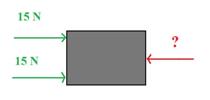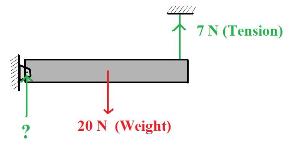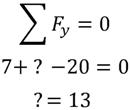LESSON 2: Sum of Forces

Seeing that there are two forces (represented as green vectors) pushing the block to the right, each with a magnitude of 15 N, what must be the magnitude of the red vector pushing the block to left? The red vector must have a magnitude of 30 N to cancel the two 15 N forces. Mathematically this looks like this:

Here is another example where a metal bar is held up by a pin joint and a wire. Let’s say the bar has a weight of 20 N and the wire has a tension of 7 N.


In the next section we will expand on this concept by using vectors that act at an angle, rather than simply using vectors that are perfectly horizontal or vertical.

Tutorial Options:
Return to Home Page
Statics Lessons Home Page
Statics Example Problems
Continue to Next Section
Return to Home Page
Statics Lessons Home Page
Statics Example Problems
Continue to Next Section
Lesson 1:
Vectors
Magnitude
Unit Vectors
Cos Angles
Lesson 2:
Sum of Forces
Sum of Forces 2
Lesson 3:
3D Sum of Forces
Lesson 4:
Moments
Moments 2
Lesson 5:
Trusses
Method of Joints
Method of Sections
Lesson 6:
Distributed Load
Vectors
Magnitude
Unit Vectors
Cos Angles
Lesson 2:
Sum of Forces
Sum of Forces 2
Lesson 3:
3D Sum of Forces
Lesson 4:
Moments
Moments 2
Lesson 5:
Trusses
Method of Joints
Method of Sections
Lesson 6:
Distributed Load